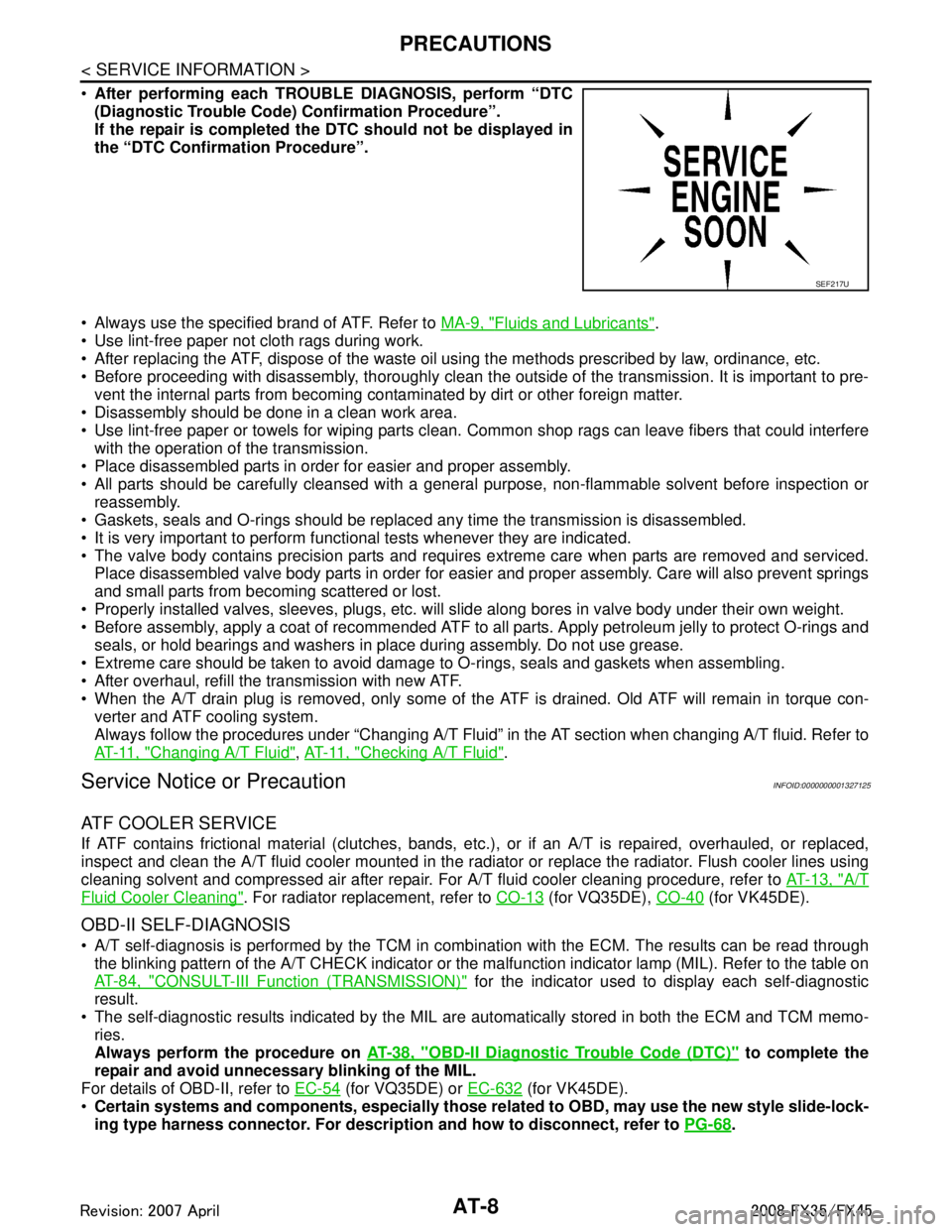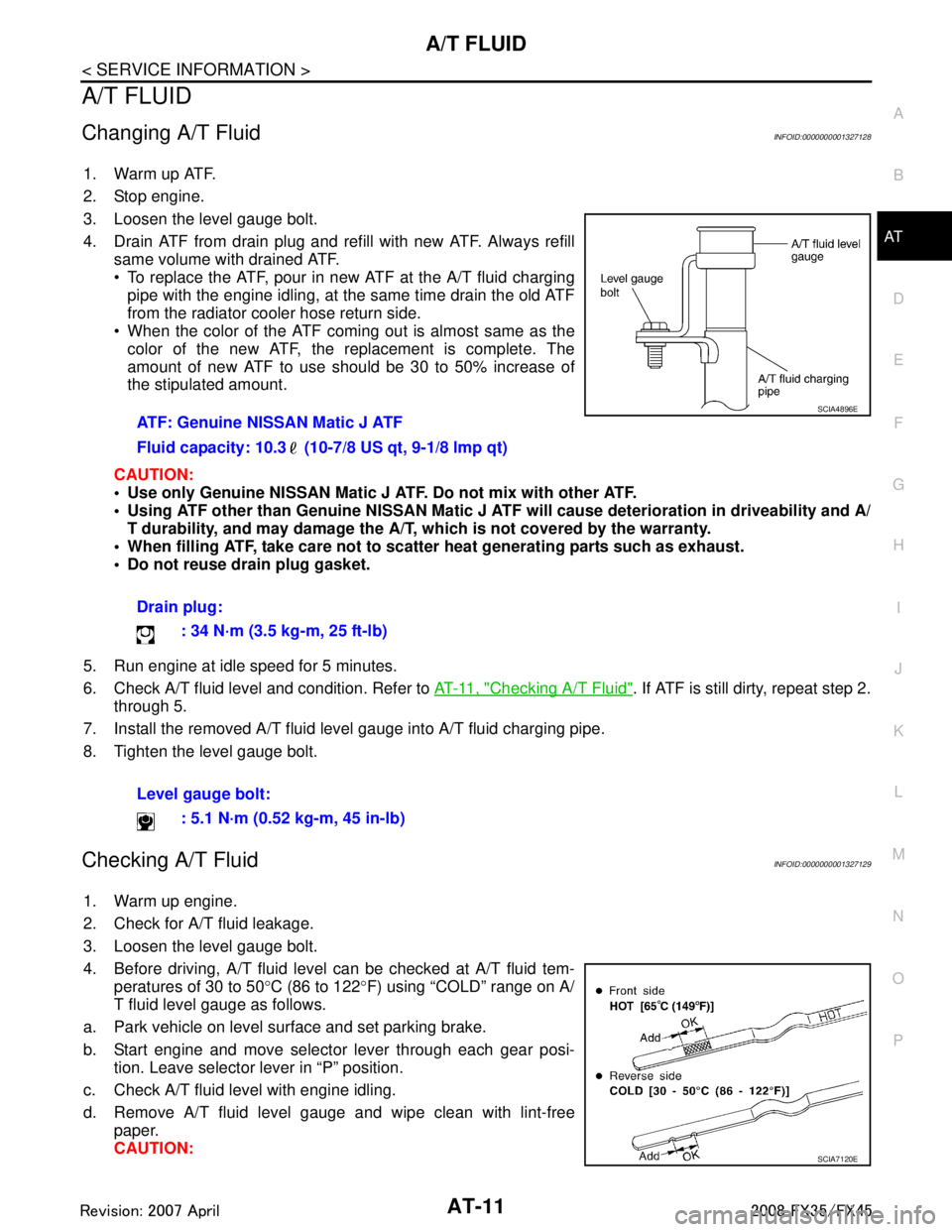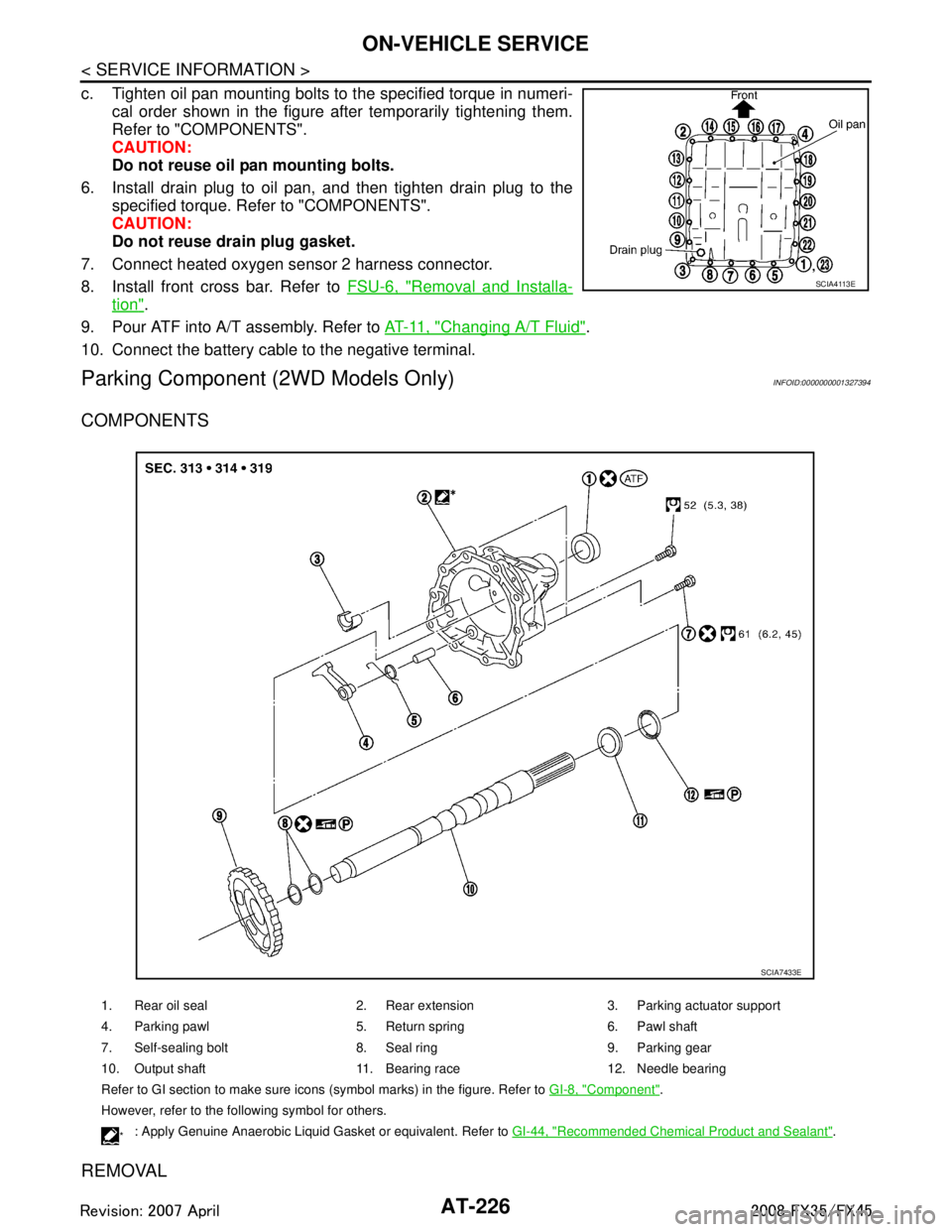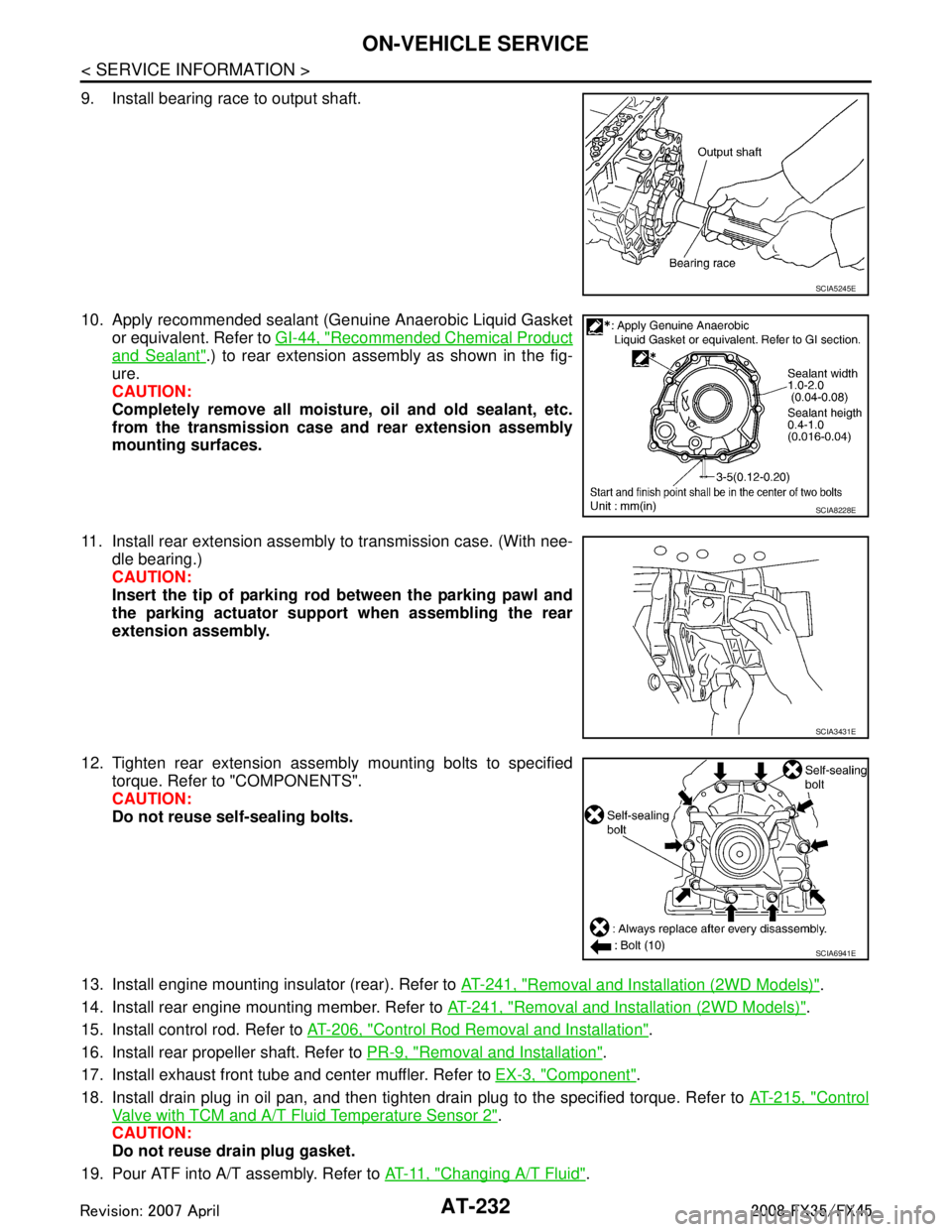changing INFINITI FX35 2008 Service Manual
[x] Cancel search | Manufacturer: INFINITI, Model Year: 2008, Model line: FX35, Model: INFINITI FX35 2008Pages: 3924, PDF Size: 81.37 MB
Page 74 of 3924

AT-1
TRANSMISSION/TRANSAXLE
DE
F
G H
I
J
K L
M
SECTION AT
A
B
AT
N
O P
CONTENTS
AUTOMATIC TRANSMISSION
SERVICE INFORMATION .. ..........................5
INDEX FOR DTC ............................................ .....5
Alphabetical Index ............................................... ......5
DTC No. Index ..........................................................5
PRECAUTIONS ...................................................7
Precaution for Supplemental Restraint System
(SRS) "AIR BAG" and "SEAT BELT PRE-TEN-
SIONER" ............................................................. ......
7
Precaution for On Board Diagnosis (OBD) System
of A/T and Engine .....................................................
7
Precaution .................................................................7
Service Notice or Precaution .....................................8
PREPARATION ...................................................9
Special Service Tool ........................................... ......9
Commercial Service Tool ..........................................9
A/T FLUID ...........................................................11
Changing A/T Fluid ............................................. ....11
Checking A/T Fluid ..................................................11
A/T Fluid Cooler Cleaning .......................................13
A/T CONTROL SYSTEM ....................................16
Cross-Sectional View (2WD Models) .................. ....16
Cross-Sectional View (VQ35DE Models for AWD) ....17
Cross-Sectional View (VK45DE Models for AWD) ....18
Shift Mechanism .................................................. ....18
TCM Function ..........................................................29
CAN Communication ...............................................30
Input/Output Signal of TCM .....................................31
Line Pressure Control .............................................31
Shift Control ............................................................33
Lock-up Control .......................................................34
Engine Brake Control ..............................................35
Control Valve ...........................................................36
ON BOARD DIAGNOSTIC (OBD) SYSTEM ......38
Introduction ......................................................... ....38
OBD-II Function for A/T System ..............................38
One or Two Trip Detection Logic of OBD-II ............38
OBD-II Diagnostic Trouble Code (DTC) .............. ....38
Malfunction Indicator Lamp (MIL) ............................40
TROUBLE DIAGNOSIS ....................................41
DTC Inspection Priority Chart ..................................41
Fail-Safe ..................................................................41
How to Perform Trouble Diagnosis for Quick and
Accurate Repair .......................................................
42
A/T Electrical Parts Location ...................................48
Circuit Diagram ........................................................49
Inspections Before Trouble Diagnosis .....................49
Road Test ................................................................53
Vehicle Speed at Which Gear Shifting Occurs ........58
Vehicle Speed at Which Lock-up Occurs/Releas-
es .............................................................................
58
Symptom Chart ........................................................59
TCM Input/Output Signal Reference Value .............83
CONSULT-III Function (TRANSMISSION) ..............84
Diagnosis Procedure without CONSULT-III ............91
DTC U1000 CAN COMMUNICATION LINE .....94
Description ........................................................... ....94
On Board Diagnosis Logic .......................................94
Possible Cause ........................................................94
DTC Confirmation Procedure ..................................94
Wiring Diagram - AT - CAN .....................................95
Diagnosis Procedure ...............................................96
DTC P0615 START SIGNAL CIRCUIT .............97
Description ...............................................................97
CONSULT-III Reference Value in Data Monitor
Mode ........................................................................
97
On Board Diagnosis Logic .......................................97
Possible Cause ........................................................97
DTC Confirmation Procedure ..................................97
Wiring Diagram - AT - STSIG ..................................98
Diagnosis Procedure ...............................................99
DTC P0700 TCM .............................................101
Description .............................................................101
On Board Diagnosis Logic .....................................101
3AA93ABC3ACD3AC03ACA3AC03AC63AC53A913A773A893A873A873A8E3A773A983AC73AC93AC03AC3
3A893A873A873A8F3A773A9D3AAF3A8A3A8C3A863A9D3AAF3A8B3A8C
Page 81 of 3924

AT-8
< SERVICE INFORMATION >
PRECAUTIONS
After performing each TROUBLE DIAGNOSIS, perform “DTC
(Diagnostic Trouble Code) Confirmation Procedure”.
If the repair is completed the DTC should not be displayed in
the “DTC Confirmation Procedure”.
Always use the specified brand of ATF. Refer to MA-9, "
Fluids and Lubricants".
Use lint-free paper not cloth rags during work.
After replacing the ATF, dispose of the waste oil using the methods prescribed by law, ordinance, etc.
Before proceeding with disassembly, thoroughly clean the out side of the transmission. It is important to pre-
vent the internal parts from becoming cont aminated by dirt or other foreign matter.
Disassembly should be done in a clean work area.
Use lint-free paper or towels for wiping parts clean. Common shop rags can leave fibers that could interfere
with the operation of the transmission.
Place disassembled parts in order for easier and proper assembly.
All parts should be carefully cleansed with a general purpose, non-flammable solvent before inspection or
reassembly.
Gaskets, seals and O-rings should be replaced any time the transmission is disassembled.
It is very important to perform functional tests whenever they are indicated.
The valve body contains precision parts and requires extreme care when parts are removed and serviced. Place disassembled valve body parts in order for easier and proper assembly. Care will also prevent springs
and small parts from becoming scattered or lost.
Properly installed valves, sleeves, plugs, etc. will s lide along bores in valve body under their own weight.
Before assembly, apply a coat of recommended ATF to all parts. Apply petroleum jelly to protect O-rings and
seals, or hold bearings and washers in place during assembly. Do not use grease.
Extreme care should be taken to avoid damage to O-rings, seals and gaskets when assembling.
After overhaul, refill the transmission with new ATF.
When the A/T drain plug is removed, only some of t he ATF is drained. Old ATF will remain in torque con-
verter and ATF cooling system.
Always follow the procedures under “Changing A/T Fluid” in the AT section when changing A/T fluid. Refer to
AT- 11 , "
Changing A/T Fluid", AT- 11 , "Checking A/T Fluid".
Service Notice or PrecautionINFOID:0000000001327125
ATF COOLER SERVICE
If ATF contains frictional material (clutches, bands, etc. ), or if an A/T is repaired, overhauled, or replaced,
inspect and clean the A/T fluid cooler mounted in the radiat or or replace the radiator. Flush cooler lines using
cleaning solvent and compressed air after repair. For A/T fluid cooler cleaning procedure, refer to AT-13, "
A/T
Fluid Cooler Cleaning". For radiator replacement, refer to CO-13 (for VQ35DE), CO-40 (for VK45DE).
OBD-II SELF-DIAGNOSIS
A/T self-diagnosis is performed by the TCM in comb ination with the ECM. The results can be read through
the blinking pattern of the A/T CHECK indicator or the malfunction indicator lamp (MIL). Refer to the table on
AT-84, "
CONSULT-III Function (TRANSMISSION)" for the indicator used to display each self-diagnostic
result.
The self-diagnostic results indicated by the MIL ar e automatically stored in both the ECM and TCM memo-
ries.
Always perform the procedure on AT-38, "
OBD-II Diagnostic Trouble Code (DTC)" to complete the
repair and avoid unnecessary blinking of the MIL.
For details of OBD-II, refer to EC-54
(for VQ35DE) or EC-632 (for VK45DE).
Certain systems and components, especially those re lated to OBD, may use the new style slide-lock-
ing type harness connector. For descrip tion and how to disconnect, refer to PG-68
.
SEF217U
3AA93ABC3ACD3AC03ACA3AC03AC63AC53A913A773A893A873A873A8E3A773A983AC73AC93AC03AC3
3A893A873A873A8F3A773A9D3AAF3A8A3A8C3A863A9D3AAF3A8B3A8C
Page 84 of 3924

A/T FLUIDAT-11
< SERVICE INFORMATION >
DE
F
G H
I
J
K L
M A
B
AT
N
O P
A/T FLUID
Changing A/T FluidINFOID:0000000001327128
1. Warm up ATF.
2. Stop engine.
3. Loosen the level gauge bolt.
4. Drain ATF from drain plug and refill with new ATF. Always refill same volume with drained ATF.
To replace the ATF, pour in new ATF at the A/T fluid chargingpipe with the engine idling, at the same time drain the old ATF
from the radiator cooler hose return side.
When the color of the ATF coming out is almost same as the
color of the new ATF, the replacement is complete. The
amount of new ATF to use should be 30 to 50% increase of
the stipulated amount.
CAUTION:
Use only Genuine NISSAN Matic J ATF. Do not mix with other ATF.
Using ATF other than Genuine NISSAN Matic J AT F will cause deterioration in driveability and A/
T durability, and may damage the A/T, which is not covered by the warranty.
When filling ATF, take care not to scatter heat generating parts such as exhaust.
Do not reuse drain plug gasket.
5. Run engine at idle speed for 5 minutes.
6. Check A/T fluid level and condition. Refer to AT- 11 , "
Checking A/T Fluid". If ATF is still dirty, repeat step 2.
through 5.
7. Install the removed A/T fluid level gauge into A/T fluid charging pipe.
8. Tighten the level gauge bolt.
Checking A/T FluidINFOID:0000000001327129
1. Warm up engine.
2. Check for A/T fluid leakage.
3. Loosen the level gauge bolt.
4. Before driving, A/T fluid level can be checked at A/T fluid tem- peratures of 30 to 50 °C (86 to 122 °F) using “COLD” range on A/
T fluid level gauge as follows.
a. Park vehicle on level surface and set parking brake.
b. Start engine and move selector lever through each gear posi- tion. Leave selector lever in “P” position.
c. Check A/T fluid level with engine idling.
d. Remove A/T fluid level gauge and wipe clean with lint-free paper.
CAUTION:ATF: Genuine NISSAN Matic J ATF
Fluid capacity: 10.3 (10-7/8 US qt, 9-1/8 lmp qt)
Drain plug:
: 34 N·m (3.5 kg-m, 25 ft-lb)
Level gauge bolt: : 5.1 N·m (0.52 kg-m, 45 in-lb)
SCIA4896E
SCIA7120E
3AA93ABC3ACD3AC03ACA3AC03AC63AC53A913A773A893A873A873A8E3A773A983AC73AC93AC03AC3
3A893A873A873A8F3A773A9D3AAF3A8A3A8C3A863A9D3AAF3A8B3A8C
Page 132 of 3924

TROUBLE DIAGNOSISAT-59
< SERVICE INFORMATION >
DE
F
G H
I
J
K L
M A
B
AT
N
O P
At closed throttle, the accelerator opening is less than 1/8 condition. (Closed throttle position signal: OFF)
At half throttle, the accelerator opening is 4/8 of the full opening.
At closed throttle, the accelerator opening is less than 1/8 condition. (Closed throttle position signal: OFF)
At half throttle, the accelerator opening is 4/8 of the full opening.
Symptom ChartINFOID:0000000001327161
The diagnostics item numbers show the sequence for inspection. Check in order from item 1.
Overhaul and check inside the A/T only if A/T fluid condition is NG. Refer to AT-49, "
Inspections Before Trou-
ble Diagnosis".
Engine model VK45DE
Throttle positionVehicle speed km/h (MPH)
Lock-up ON Lock-up OFF
Closed throttle 66 - 74 (41 - 46) 53 - 61 (33 - 38)
Half throttle 191 - 199 (119 - 124) 145 - 153 (90 - 95)
No. Items Symptom Condition Diagnostic Item Reference
page
1 Shift
Shock Large shock. (“N”
→
“D” position)
Refer to AT- 1 7 3 ,
"Large Shock ("N" to
"D" Position)". ON vehicle 1. Engine idle speed
EC-84
(for
VQ35DE)
or EC-661
(for
VK45DE)
2. Engine speed signal AT- 11 2
3. Accelerator pedal position sensorAT- 1 3 0
4. A/T positionAT- 2 0 7
5. A/T fluid temperature sensorAT- 1 3 2
6. Front brake solenoid valveAT- 1 4 5
7. CAN communication line AT- 9 4
8. A/T fluid level and stateAT- 4 9
9. Line pressure testAT- 4 9
10. Control valve with TCMAT- 2 1 5
OFF vehicle11. Forward brake (Parts behind drum support is impossible
to perform inspection by disassembly. Refer to
AT- 1 6 , "
Cross-
Sectional View (2WD Models)", AT- 1 7 , "Cross-Sectional View
(VQ35DE Models for AWD)" or AT- 1 8 , "Cross-Sectional View
(VK45DE Models for AWD)") AT- 2 6 7
2
Shock is too large
when changing D1
→
D
2 or M1 → M2. ON vehicle 1. Accelerator pedal position sensor
AT- 1 3 0
2. A/T positionAT- 2 0 7
3. Direct clutch solenoid valveAT- 1 4 7
4. CAN communication line AT- 9 4
5. Engine speed signalAT- 11 2
6. Turbine revolution sensorAT- 1 0 6
7. Vehicle speed sensor A/T and vehicle speed sensor MTRAT- 1 0 8,
AT- 1 3 7
8. A/T fluid level and state AT- 4 9
9. Control valve with TCMAT- 2 1 5
OFF vehicle 10. Direct clutch AT- 3 0 3
3AA93ABC3ACD3AC03ACA3AC03AC63AC53A913A773A893A873A873A8E3A773A983AC73AC93AC03AC3
3A893A873A873A8F3A773A9D3AAF3A8A3A8C3A863A9D3AAF3A8B3A8C
Page 133 of 3924

AT-60
< SERVICE INFORMATION >
TROUBLE DIAGNOSIS
3Shift
Shock Shock is too large
when changing D2
→
D
3 or M2 → M3. ON vehicle 1. Accelerator pedal position sensor
AT- 1 3 0
2. A/T positionAT- 2 0 7
3.High and low reverse clutch solenoid valveAT- 1 4 9
4. CAN communication line AT- 9 4
5. Engine speed signalAT- 11 2
6. Turbine revolution sensorAT- 1 0 6
7. Vehicle speed sensor A/T and vehicle speed sensor MTRAT- 1 0 8,
AT- 1 3 7
8. A/T fluid level and state AT- 4 9
9. Control valve with TCMAT- 2 1 5
OFF vehicle 10. High and low reverse clutch AT- 3 0 1
4Shock is too large
when changing D3
→
D
4 or M3 → M4. ON vehicle 1. Accelerator pedal position sensor
AT- 1 3 0
2. A/T positionAT- 2 0 7
3. Input clutch solenoid valveAT- 1 4 3
4. CAN communication line AT- 9 4
5. Engine speed signalAT- 11 2
6. Turbine revolution sensorAT- 1 0 6
7. Vehicle speed sensor A/T and vehicle speed sensor MTRAT- 1 0 8,
AT- 1 3 7
8. A/T fluid level and state AT- 4 9
9. Control valve with TCMAT- 2 1 5
OFF vehicle 10. Input clutch AT- 2 8 9
5Shock is too large
when changing D4
→
D
5 or M4 → M5. ON vehicle1. Accelerator pedal position sensor
AT- 1 3 0
2. A/T positionAT- 2 0 7
3. Front brake solenoid valveAT- 1 4 5
4. CAN communication line AT- 9 4
5. Engine speed signalAT- 11 2
6. Turbine revolution sensorAT- 1 0 6
7. Vehicle speed sensor A/T and vehicle speed sensor MTRAT- 1 0 8,
AT- 1 3 7
8. A/T fluid level and state AT- 4 9
9. Control valve with TCMAT- 2 1 5
OFF vehicle10. Front brake (brake band)
AT- 2 4 911. Input clutchAT- 2 8 9
No. Items Symptom Condition Diagnostic Item Reference
page
3AA93ABC3ACD3AC03ACA3AC03AC63AC53A913A773A893A873A873A8E3A773A983AC73AC93AC03AC3
3A893A873A873A8F3A773A9D3AAF3A8A3A8C3A863A9D3AAF3A8B3A8C
Page 296 of 3924

ON-VEHICLE SERVICEAT-223
< SERVICE INFORMATION >
DE
F
G H
I
J
K L
M A
B
AT
N
O P
c. Tighten oil pan mounting bolts to the specified torque in numeri- cal order shown in the figure after temporarily tightening them.
Refer to "COMPONENTS".
CAUTION:
Do not reuse oil pan mounting bolts.
16. Install drain plug to oil pan, and then tighten drain plug to the specified torque. Refer to "COMPONENTS".
CAUTION:
Do not reuse drain plug gasket.
17. Pull up A/T assembly harness connector. CAUTION:
Be careful not to damage connector.
18. Install snap ring to A/T assembly harness connector.
19. Connect A/T assembly harness connector.
20. Connect heated oxygen sensor 2 harness connector.
21. Install front cross bar. Refer to FSU-6, "
Removal and Installa-
tion".
22. Pour ATF into A/T assembly. Refer to AT- 11 , "
Changing A/T
Fluid".
23. Connect the battery cable to the negative terminal.
A/T FLUID TEMPERATURE SENSOR 2 REMOVAL AND INSTALLATION
Removal
1. Disconnect the battery cabl e from the negative terminal.
2. Remove front cross bar. Refer to FSU-6, "
Removal and Installation".
3. Disconnect heated oxygen sensor 2 harness connector.
4. Drain ATF through drain plug.
5. Remove bracket (1) (VK45DE), clips (2), oil pan (3) and oil pan gasket.
: Vehicle front
: Bolt (22)
Drain plug (4)
SCIA4113E
SCIA5038E
SCIA5039E
SCIA8128E
3AA93ABC3ACD3AC03ACA3AC03AC63AC53A913A773A893A873A873A8E3A773A983AC73AC93AC03AC3
3A893A873A873A8F3A773A9D3AAF3A8A3A8C3A863A9D3AAF3A8B3A8C
Page 299 of 3924

AT-226
< SERVICE INFORMATION >
ON-VEHICLE SERVICE
c. Tighten oil pan mounting bolts to the specified torque in numeri-cal order shown in the figure after temporarily tightening them.
Refer to "COMPONENTS".
CAUTION:
Do not reuse oil pan mounting bolts.
6. Install drain plug to oil pan, and then tighten drain plug to the specified torque. Refer to "COMPONENTS".
CAUTION:
Do not reuse drain plug gasket.
7. Connect heated oxygen sensor 2 harness connector.
8. Install front cross bar. Refer to FSU-6, "
Removal and Installa-
tion".
9. Pour ATF into A/T assembly. Refer to AT- 11 , "
Changing A/T Fluid".
10. Connect the battery cable to the negative terminal.
Parking Component (2WD Models Only)INFOID:0000000001327394
COMPONENTS
REMOVAL
SCIA4113E
1. Rear oil seal 2. Rear extension 3. Parking actuator support
4. Parking pawl 5. Return spring 6. Pawl shaft
7. Self-sealing bolt 8. Seal ring 9. Parking gear
10. Output shaft 11. Bearing race 12. Needle bearing
Refer to GI section to make sure icons (symbol marks) in the figure. Refer to GI-8, "
Component".
However, refer to the following symbol for others.
*: Apply Genuine Anaerobic Liquid Gasket or equivalent. Refer to GI-44, "Recommended Chemical Product and Sealant".
SCIA7433E
3AA93ABC3ACD3AC03ACA3AC03AC63AC53A913A773A893A873A873A8E3A773A983AC73AC93AC03AC3
3A893A873A873A8F3A773A9D3AAF3A8A3A8C3A863A9D3AAF3A8B3A8C
Page 305 of 3924

AT-232
< SERVICE INFORMATION >
ON-VEHICLE SERVICE
9. Install bearing race to output shaft.
10. Apply recommended sealant (Genuine Anaerobic Liquid Gasketor equivalent. Refer to GI-44, "
Recommended Chemical Product
and Sealant".) to rear extension assembly as shown in the fig-
ure.
CAUTION:
Completely remove all moisture, oil and old sealant, etc.
from the transmission case and rear extension assembly
mounting surfaces.
11. Install rear extension assembly to transmission case. (With nee- dle bearing.)
CAUTION:
Insert the tip of parking rod between the parking pawl and
the parking actuator support when assembling the rear
extension assembly.
12. Tighten rear extension assembly mounting bolts to specified torque. Refer to "COMPONENTS".
CAUTION:
Do not reuse self-sealing bolts.
13. Install engine mounting insulator (rear). Refer to AT-241, "
Removal and Installation (2WD Models)".
14. Install rear engine mounting member. Refer to AT-241, "
Removal and Installation (2WD Models)".
15. Install control rod. Refer to AT-206, "
Control Rod Removal and Installation".
16. Install rear propeller shaft. Refer to PR-9, "
Removal and Installation".
17. Install exhaust front tube and center muffler. Refer to EX-3, "
Component".
18. Install drain plug in oil pan, and then tighten drain plug to the specified torque. Refer to AT-215, "
Control
Valve with TCM and A/T Fluid Temperature Sensor 2".
CAUTION:
Do not reuse drain plug gasket.
19. Pour ATF into A/T assembly. Refer to AT- 11 , "
Changing A/T Fluid".
SCIA5245E
SCIA8228E
SCIA3431E
SCIA6941E
3AA93ABC3ACD3AC03ACA3AC03AC63AC53A913A773A893A873A873A8E3A773A983AC73AC93AC03AC3
3A893A873A873A8F3A773A9D3AAF3A8A3A8C3A863A9D3AAF3A8B3A8C
Page 311 of 3924

AT-238
< SERVICE INFORMATION >
ON-VEHICLE SERVICE
Completely remove all moisture, oil and old gasket, etc. from oil pan mounting surface.
b. Install oil pan (2) (with oil pan gasket) and clips (1) to transmis- sion case.
: Vehicle front
: Bolt (22)
CAUTION:
Install it so that drain plug (3) comes to the position as
shown in the figure.
Be careful not to pinch harnesses.
Completely remove all moisture, oil and old gasket, etc. from oil pan mounting surface.
c. Tighten oil pan mounting bolts to the specified torque in numeri- cal order shown in the figure after temporarily tightening them.
Refer to "COMPONENTS".
CAUTION:
Do not reuse oil pan mounting bolts.
9. Install drain plug to oil pan, and then tighten drain plug to the specified torque. Refer to "COMPONENTS".
CAUTION:
Do not reuse drain plug gasket.
10. Install control rod. Refer to AT-206, "
Control Rod Removal and
Installation".
11. Install rear propeller shaft. Refer to PR-9, "
Removal and Installa-
tion".
12. Install exhaust front tube and center muffler. Refer to EX-3, "
Component".
13. Install front cross bar. Refer to FSU-6, "
Removal and Installation".
14. Pour ATF into A/T assembly. Refer to AT- 11 , "
Changing A/T Fluid".
15. Connect the battery cable to the negative terminal.
SCIA8117E
SCIA4113E
3AA93ABC3ACD3AC03ACA3AC03AC63AC53A913A773A893A873A873A8E3A773A983AC73AC93AC03AC3
3A893A873A873A8F3A773A9D3AAF3A8A3A8C3A863A9D3AAF3A8B3A8C
Page 424 of 3924

REFRIGERATION SYSTEMATC-19
< SERVICE INFORMATION >
C
DE
F
G H
I
K L
M A
B
AT C
N
O P
Operation
1. Control Valve
- By changing high-pressure valve lift amount, built-in electronic control valve executes the following:
Controls high-pressure valve discharge amount.
Changes crankcase pressure in compressor.
Changes angle of wobble (swash) plate.
- Amount of high-pressure valve lift is determined by factors below.
Low-pressure applied to diaphragm
Spring load of set spring
Balance of magnetic force generated in magnet coil
- Electronic control valve (ECV) magnet coil receives
electric signal (duty control) from unified meter and A/
C amp. Then, magnetic force generated by electric cu rrent is changed to control high-pressure valve lift
amount.
2. Maximum Cooling
High-pressure valve is closed by magnetic force gener ated by electric signal sent from unified meter and
A/C amp. At this time, cylinder moves full stroke due to pressure balance between inside crankcase (Pc)
and suction line (Ps).
Under this condition, the wobble (swash) plat e is set to the maximum stroke position.
3. Capacity Control When no electric signal is sent from unified meter and A/C amp. (current: OFF), high-pressure valve is
opened by spring force.
Since suction pressure is low, it makes the su ction port close and the discharge port open. Thus, crank-
case pressure becomes high as high-pressure enters the crankcase.
- The force acts around the journal pin near the wobble (swash) plate, and is generated by the pressure dif-
ference before and behind the piston.
- The drive lug and journal pin are located where t he piston generates the highest pressure. Piston pres-
sure is between suction pressure Ps and discharge pressu re Pd, which is close to suction pressure Ps. If
crankcase pressure Pc rises due to capacity contro l, the force around the journal pin makes the wobble
(swash) plate angle decrease and also the piston stroke decrease. In other words, crankcase pressure
SJIA0547E
3AA93ABC3ACD3AC03ACA3AC03AC63AC53A913A773A893A873A873A8E3A773A983AC73AC93AC03AC3
3A893A873A873A8F3A773A9D3AAF3A8A3A8C3A863A9D3AAF3A8B3A8C